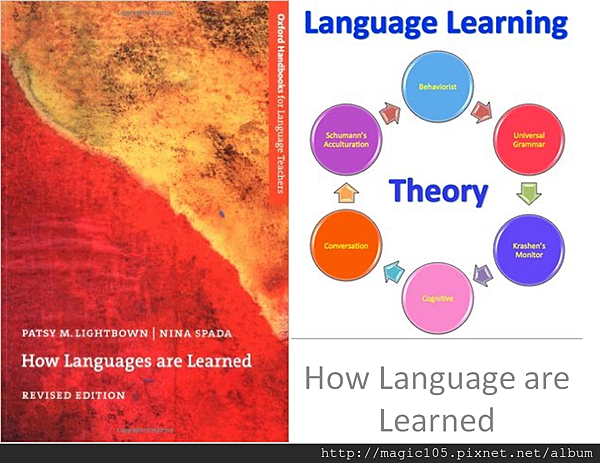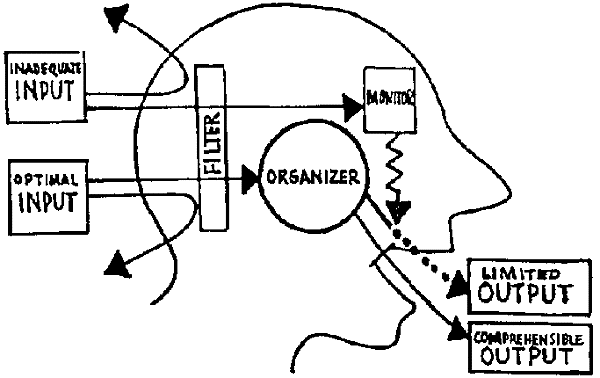
語言習得是大學的選修的課程,因為市教大老師教得太好了,於是我之後在英語高階研習再次遇到理論這塊,可以很快的上手。但是人生還是需要不斷地複習以及自我加強,於是寫篇文章以紀念那段認真讀書的日子。
第一語言是如何習得的呢? 這方面有許多說法
![]() 行為主義 behaviorism 1940 @ usa
行為主義 behaviorism 1940 @ usa
行為主義學家認為: 語言的習得是透過模仿,練習,成功的回饋以及習慣的養成,當然孩子的模仿也不盡然照單全收,他是有選擇性的,孩子只會模仿當新的語句。然而模仿不能解釋為什麼孩子能創造新的用法或是字詞。
- language learning is the result of imitation, practice, feedback on success and habit formation.
- learner has an intuitive appeal to learn the first language.
- kids' imitation is selective which goes on new work and structure.
However, imitation can't explain why kids can create some forms of language.
![]() contrastive analysis hypothesis
contrastive analysis hypothesis
- IF there are similarities between L1 AND L2, L2 will be learned with ease.
- that's normal people will have develmental error while we are learning a language.
![]() Innatism (it's all in your mind)
Innatism (it's all in your mind)
- Noam Chomsky uses language acquisition device and universal grammar to explain that although kids' input sometimes are wrong, they can still adjust it and extract a correct one.
- LAD & UG can explain why kids can creat their language that Behaviorism can't tell.
![]() THE CRITICAL PERIOD HYPOTHESIS
THE CRITICAL PERIOD HYPOTHESIS
-Lennberg states that the first language can be learned only when it stimulated at the right time.
![]() social interactionism
social interactionism
- interactionist puts more emphesis on the linguistic enviroment in interaction.
- one on one interaction gives the child access to language which is adjusted to child's level of comprehension.
- Piaget states that kids' cognitive development would determine how kids use the language.
- Vygosky uses zone of proximal development to states the social interaciton plays a great role on language develoment.
![]() Child-directed speech
Child-directed speech
adults will modify the way they speak to little children like higher pictch, simpler sentence pattern. Even though the inputs are simplerfied, the kids have the ability to form a formal language.
![]() to sum up
to sum up
1. Behaviorism and connectionist may explain the acquisition of vocabularies and grammatical morphemes.
2. Innatists explain the acquisition of complex grammar or sentence pattern.
3. Interactionists explain the kids' how to use the language appropriately related the form of language and meaning.
英語學習分成EFL& ESL一個是當成外國語言學習,一個是當成第二語言學習。 English as a foreign language vs English as a second language。 台灣目前是EFL 所以在第二外語習得的部分也有幾個理論,大家可以參考:
![]() Krashen's monitor model
Krashen's monitor model
語言如果只是learning 你就無法在真實的世界中去實用它。但是如果你acquire it 你可以應用語言在你真實的人生中。台灣的語言學習多半停留在學習而非習得。

![]() the acquistion-learning hypotheis
the acquistion-learning hypotheis
- we acquire a language with no conscious attetion to the language form. In contrast, we learn a language via conscious process of study and pay highly attention on the forms or rules learning.
- learning can't turn into acquisition. that is, speakers may know the grammatical rules but theu fail to apply them in to real lives.
![]() the monitor hypothesis
the monitor hypothesis
- speakers who acquire a language produce spontaneously intuitive judgements.
- speakers who learn a language monify the way to speak in correct way.
![]() the natural order hypothesis
the natural order hypothesis
- even advanced speaker while speaking in rapid conversation would make some grammatical morpheme mistakes.
![]() the input hypothesis i+1
the input hypothesis i+1
- when the input contains forms and structures which beyond the learner's current level of compentence in the language, both comprhension and acquisition will occur.
![]() the affective filter hypothesis
the affective filter hypothesis
-emotion maybe a barrier that prevents learners from acquire a language so communicative language teaching is encouraged to use in english learning.
![]() cognitive theory
cognitive theory
- they focus on the conscious of people, the leaners are active participant, they have to pay attention or notice until they realize.
- they also work on an information processing as building up knowledge that speakers could eventually automatically for speaking and understanding.
![]() connectionism
connectionism
- connectists states that learners bulit up their knowledge of language by the exposure of linguistic feature many times and they develop stronger mental or neurological connection between these elements and they learned.
![]() the interactionist
the interactionist
- how to make inputs more comprehensible
1. interactional modification make input more comprehensible.
2. comprehensible inputs promote accquisition.
3. interactional modification promotes accqisiton.
![]() factors affect second language learning
factors affect second language learning
- intelligence won't affect learners' oral productive skills but in reading grammar and vocagbulries.





 留言列表
留言列表